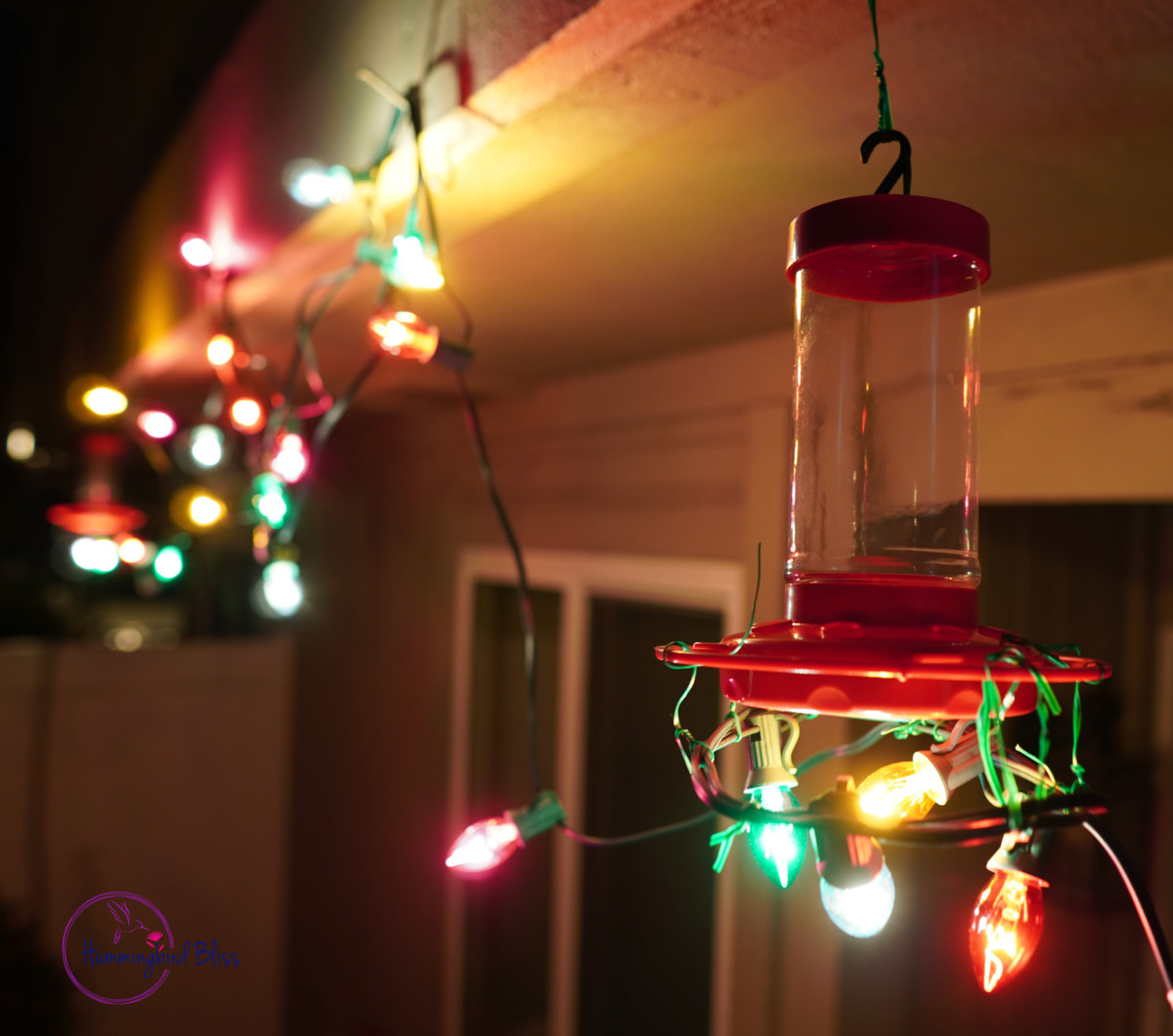This post contains affiliate links.
If your hummingbird feeder is freezing, you can bet your neighbor’s feeders are experiencing the same dilemma.
Hummingbird nectar has a lower freezing point than water because of it’s sugar concentrate. The recommended hummingbird nectar recipe of one part sugar to four parts water freezes at 27 degrees Fahrenheit but starts to become “slushy” at 29 degrees Fahrenheit.
Believe it or not, there are solutions to prevent nectar from freezing, thereby helping hummingbirds obtain the desperately needed nutrition in order to survive the cold winter temperatures.
How do you keep hummingbird nectar from freezing?
1). Surround a feeder with holiday lights
2). Activate and attach a hand warmer to the feeder
3). Insulate the feeders
4). Set up an outdoor work light
5). Use window feeders
6). Apply heating tape
7). Place the feeder under a covered porch
8). Rotate feeders
9). Bring feeders indoors overnight
10). Add snow baffle weather domes
11). Attach a heated hummingbird feeder
This article emphasizes how to maintain hummingbird feeder nectar in a fluid form during the cold temperatures so that the hummingbirds have access to fluid nectar to get vital energy.
Hummingbirds require a constant supply of food sources to support their high metabolism during cold spells. The availability of liquid nectar is a factor of life or death as hummingbirds attempt to replenish their energy source after awakening from torpor.
Many Anna’s hummingbirds are year-round residents of the Pacific West Coast in the United States though some may migrate south for the winter with the Allen’s, Rufous and Black-chinned hummingbirds of the area.
Staying alive during the winter months, Anna’s hummingbirds that are native residents that do not migrate rely heavily on the feeders provided by the hummingbird enthusiasts, when the natural abundance of nectar is scarce.
To assist your friends during the cold weather, particularly the Anna’s hummingbirds, below are some helpful recommendations.
Surround a Feeder with Holiday Lights
During the winter season, holiday cheer is infectious, so continue the festivities while keeping the hummingbird nectar fluid by wrapping a strand of outdoor non-LED holiday lights.
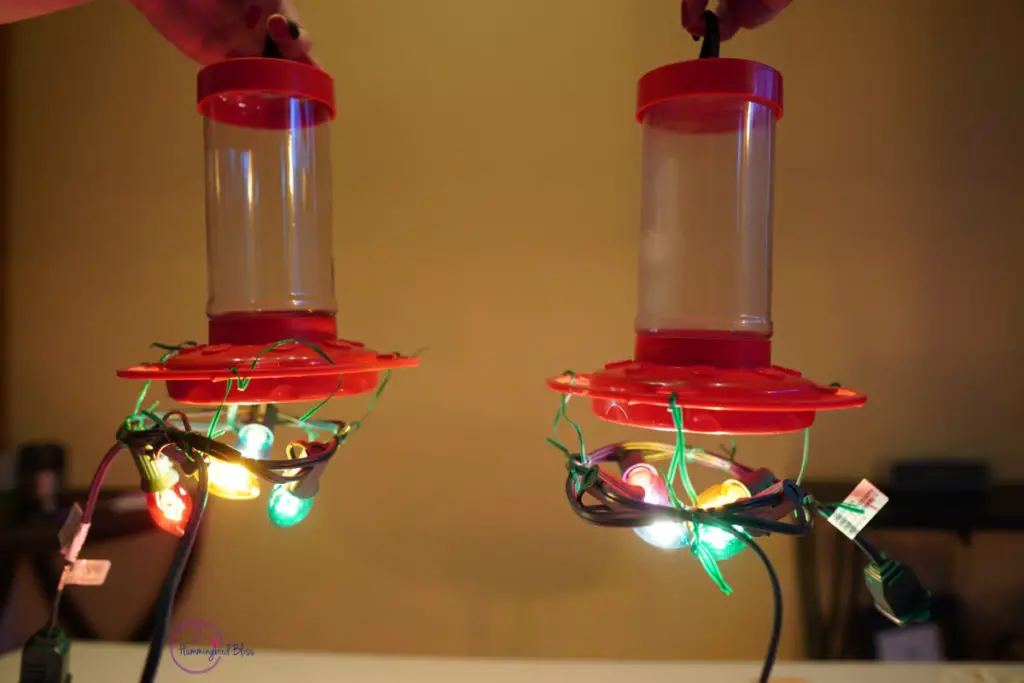
Place the non-LED lights above, around, and below the hummingbird feeder. The constant heat that radiates from the non-LED lights provides enough warmth to keep the hummingbird nectar from freezing.
Low voltage high efficiency LED lights do not produce the heat required to warm the feeder nectar.
Red outdoor lights will help to attract the attention of your hummingbirds, but any colored lights will work since the main motive is to keep the nectar in fluid form and to keep it from freezing.
Note: In my opinion the LED lights do not produce enough heat to keep hummingbird nectar from freezing in really cold weather, but it does show how many hummingbirds do hang around during the winter.
Between glass and plastic feeders, glass is durable and can withstand the heat emitted from the non-LED lights. Plastic feeders may melt, warp or cause damage to its surroundings when pressed against the surface of the feeder.
Always use lights that are designated for outdoor use. Perform a safety check with your string of lights. Make sure to remove and replace all broken light bulbs, frayed cords or split wires.
Weatherproof the ends by wrapping them with electrical tape to prevent moisture from entering and causing an incomplete circuit or starting a fire.
I recommend connecting the lights to a timer to control when and for how long the feeder is being heated.
Since each scenario is different, consider the outside temperature, time of day, hours of daylight and placement of the feeder. Examine whether it is north facing or south facing and the quantity of nectar in the feeder when calculating the length of time to warm the feeder.
Also, understand that the hummingbirds are hungry right after they come out of torpor in the morning and just before they go into torpor for the night. These two times of the day are when the temperatures are the coldest and are the most vital times for the hummingbirds to have homemade nectar in liquid form available to them.
See my article: Forget Commercial Hummingbird Food Try Making Homemade Nectar
Activate and Attach a Hand Warmer to the Feeder
An inexpensive way to keep the feeder nectar from freezing is with the use of hand warmers. They are approximately the size of a cell phone and can be purchased at most sporting goods stores.
There are single use disposable, reusable and battery operated hand warmers.
The Seattle Audubon Society in Washington state suggests when feeding hummingbirds during the winter to duct tape and attach a hand warmer to the feeder while keeping it close to the opening ports where they feed.
The difficulty of using duct tape especially on the plastic feeders is that it can leave glue residue on the feeder.
I suggest cutting the toe off of an old sock and placing the feeder through the sock tube until it is completely surrounded. Slipping the hand heater between the sock and the feeder receptacle helps to add an extra layer of effective insulation.
This gentle heat lasts for approximately 60 minutes and emits enough warmth to keep the nectar from freezing so that the hummingbirds have access to precious liquid food.
Some brands are air activated by shaking the packet. Others require bending a piece of metal that is inside the warmer which causes a chemical reaction. Then, there is the battery operated heater.
Environmental Note: When disposing of the single use hand warmer, make sure your brand is environmentally friendly and dispose of it accordingly.
Insulate the Feeders
Creativity is the key when insulating feeders. The sky is the limit on innovative hummingbird feeder covers. Some ideas to consider are:
- Flexible foam pipe insulation
- Oven mitt
- Fashion an old sock, knit or crochet an insulation cover
- Bubble wrap
Flexible foam pipe insulation purchased at the local hardware store is an excellent insulation material. First measure the length and circumference of the feeder. Cut and connect the two insulation pieces together to the feeder reservoir. Lastly, securely attach the foam pipe to the feeder with tape, rubber bands, Velcro straps, zip ties or flexible galvanized steel wire with a wire cutter on the package.
In my experience, I first measured the length and circumference of my feeder which is 5 inches in length and 3 inches in diameter.
Then, I cut two 5-inch-long pieces of a 2-inch foam pipe insulation. I cut the second foam pipe in half to make up the remaining 1 inch and connected one side together with the existing self-sealing adhesive tape on the pipe insulation.
I left the other adhesive side open so as to not complete the circle and connect everything together. (I know your first instinct is to complete the circle which was exactly my first inclination). I found by not fully connecting the foam pipe it allows for easy on and off application when cleaning and refilling the feeders.
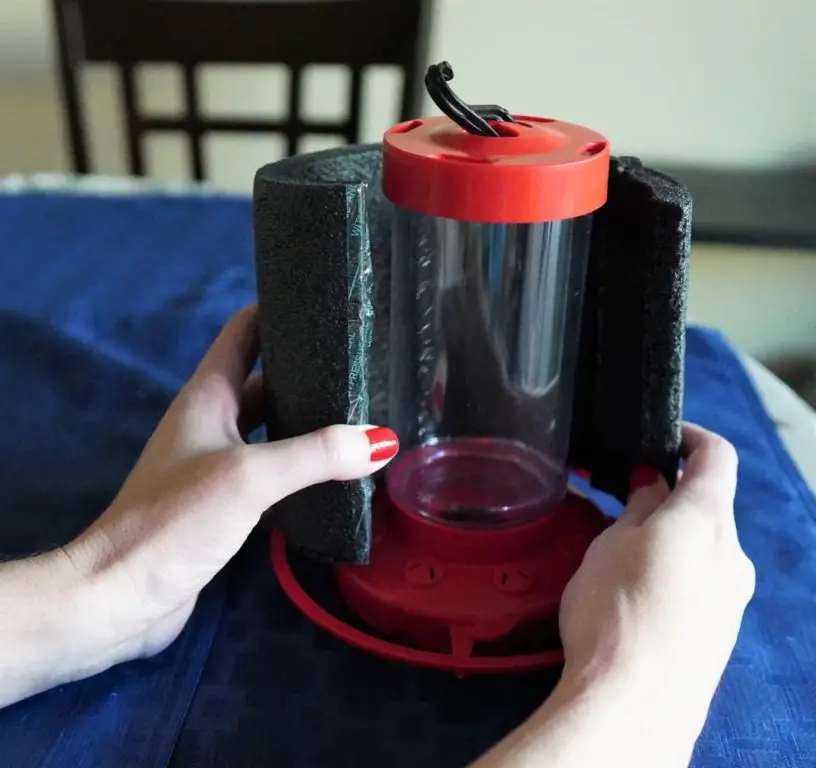
Lastly, I applied the now newly 3-inch foam piece to the circumference of the feeder reservoir and securely attached it with rubber bands.
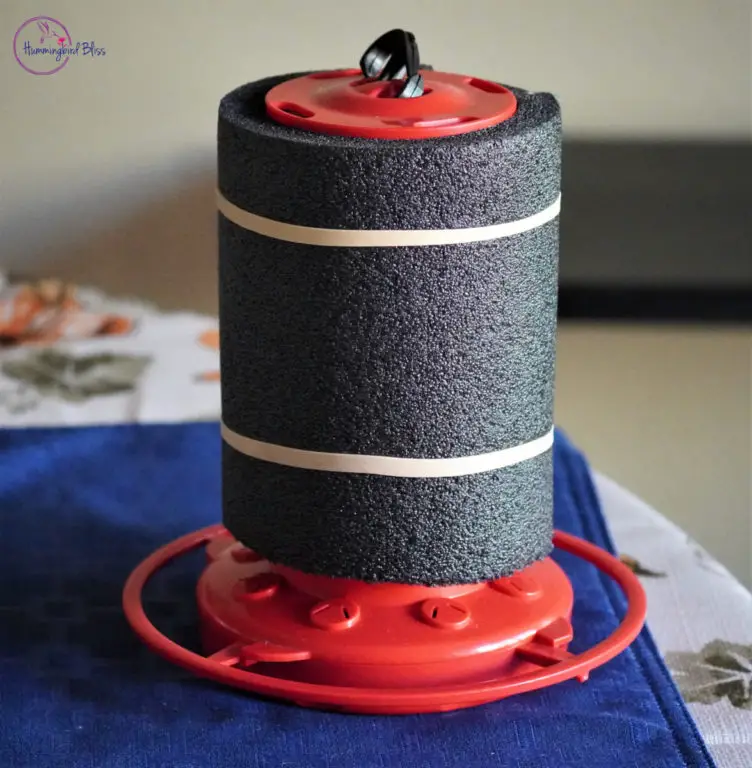
An Oven mitt can also be used as insulation. There are two ways that I have discovered to secure the oven mitt to the feeder. The first way is to cut the oven mitt in half to fit the length of the feeder reservoir.

Just as the British use a tea cozy to keep the tea warm in the teapot, consider making a cozy for the hummingbird nectar reservoir. Make sure to secure the edges so that it does not fray either by stitching a hem or by using a glue gun. Unstitch a small section of the tip of the prefabricated oven mitt to allow the hook to pass through so the feeder can be hung from a hanger.
The other option is to use the remaining wrist section of the oven mitt after it has been cut in half (we don’t want anything to go to waste) and wrap it around the reservoir.
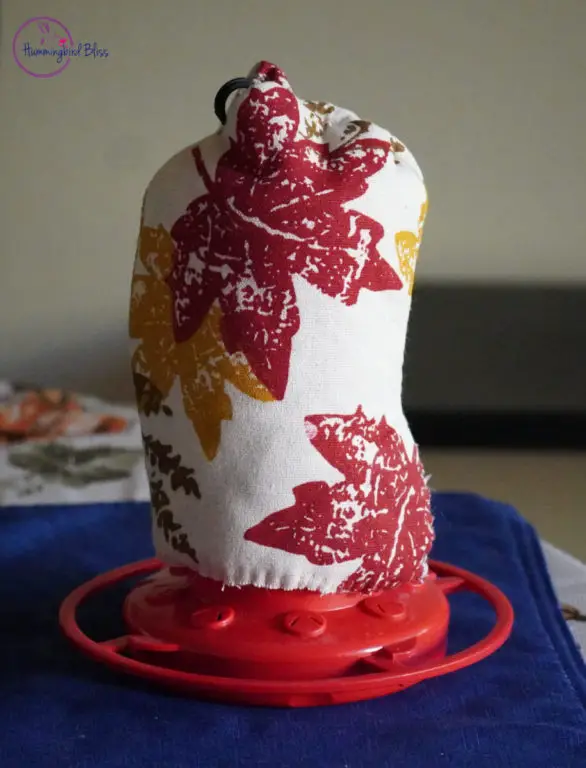
Fashion an old sock, knit or crochet an insulation cover for the feeder. Use an old sock and cut off the toe creating a tube sock.
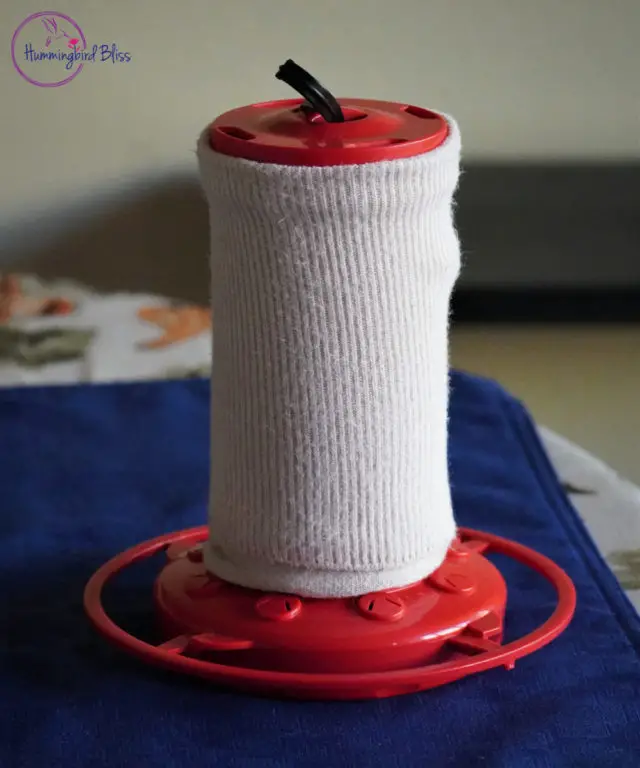
Socks fabricated from synthetic blends usually consist of two or more natural and artificial fibers. Synthetic blends such as nylon and polyester repel moisture and dry faster than natural fibers.
Wool is a natural fiber that maintains warmth and breathes. The drawback to using wool is once wet, it takes a long time to dry. A technique to consider if choosing this route is to cover the wool with a light coat of lanolin (which is a natural oil from wool) as a water repellent. Also remember that wool if placed in the dryer will shrink and may not fit again on the feeder reservoir.
Once the toe of the old sock is removed you now have a tube sock with two open ends. Place the tube sock over the hummingbird feeder reservoir to help insulate the feeder.
Bubble wrap used as insulation can help to ward off the impending cold when wrapped around the feeder. It may be the difference between a little available liquid nectar or solid frozen ice. Cover as much of the reservoir without obstructing the feeding area.
Be mindful that there is not any extraneous plastic from the bubble wrap that might impede the safety of the hummingbird. Securely attach the bubble wrap to the feeder with tape, rubber bands, Velcro straps or zip ties.
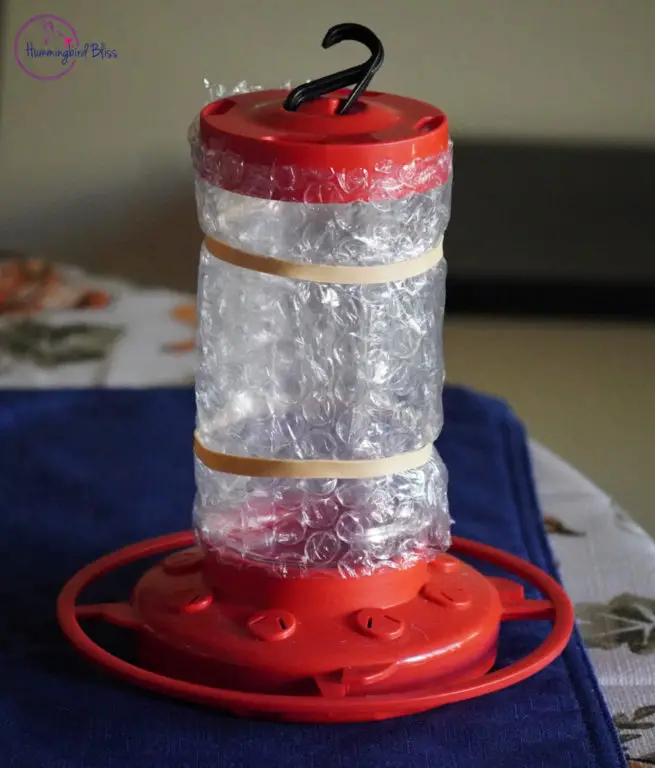
Set Up an Outdoor Work Light
Hang an incandescent mechanic’s work light or flood light to warm up the ambient temperature around the feeder. I recommend using a non LED light that uses a 75-watt light bulb which will produce 95 degree Fahrenheit of warmth. When purchasing a mechanic’s work light make sure to pick one that is for indoor/outdoor use.
Place the light 8 to 12 inches away from the feeder to make sure that it is not too close to possibly melting the plastic feeder base or that it is not too warm for the hummingbird as it is feeding.
For safety purposes connect the outdoor work light to a timer and make sure all of the electrical connections are weatherproofed to protect from moisture entering and causing short circuiting.
Use Window Feeders
Window feeders are not only wonderful to use during the summer months to get a close look at your hummingbird guests while they are busy with activity, but are equally useful during the winter.
A home will generate heat from an active kitchen, a fire in the fireplace, or from the burning furnace keeping the whole house warm. Any wall or window of the house will act as a heat conductor.
Depending on how cold the surrounding outside temperatures are before the heat has time to dissipate, a hummingbird feeder placed on the window has a higher chance of the nectar staying in fluid form.
A hummingbird window feeder near the structure of a house, protected under an eave or attached on a window, allows the hummingbird to rest and take a sip of energy from an unfrozen feeder while waiting for a break in the weather.
This window feeder technique to keep hummingbird nectar from freezing is most effective in homes with single pane windows. Due to energy conservation code mandates on new construction, newer homes often have double pane windows which decrease the effectiveness of using these techniques.
Note: Window feeders also increase the risk of the hummingbird colliding with the glass pane, so be sure to use decals to warn the hummingbird of the potential danger. Holiday decals work great.
Apply Heating Tape
The Seattle Audubon Society in Washington state also suggests using plumber’s heat tape to keep the feeder nectar from freezing. The heating tape is primarily designed to prevent water pipes from freezing however can be used to keep hummingbird nectar fluid and helps our friends in the snowy cold winter days.
Even though it is called plumbers tape, it is a non-adhesive tape that looks more like a flexible flat extension cord with a silicone coating. It can be purchased at any local home supply or hardware store. There are various lengths of heating tape therefore, make sure to purchase the shortest length that will cover the feeder. There are some products where the temperature is pre-set and thermostatically controlled.
Wrap the plumber’s heating tape around the reservoir portion of the feeder and plug it into an electrical source. Use electrical tape to attach the heating tape to your glass feeder.
If using a thermostatically controlled tape, first, attach the thermostat to your feeder using electrical tape then begin to wrap the heating tape around the feeder. Secondly, use another piece of electrical tape to seal the opposite end.
The power outlet used to connect to the heating tape needs to be GFCI (Ground Fault Circuit Interrupter) approved. This means the GFCI is constantly monitoring current flow through a circuit to prevent possible shocks or electrocutions.
Most 3 prong plugs are standard GFCI approved and have a reset button.
Do not use an extension cord between the heating tape and the power outlet.
Note: Never overlap the heating tape, this can cause a fire hazard!!!
Place the Feeder Under a Covered Porch
During the cold weather months, it is important to scan your area for any nooks protected from the elements. Great places to utilize are under the eaves of your house or under a covered porch.
Hummingbird feeders protected from snow and freezing rain will help to keep feeder ports unclogged and available.
The snow on the feeder can cause a blockage in the ports so that even if the nectar in the reservoir is not frozen, the hummingbird may not be able to place his beak in the feeder vent to access the nectar through the opening ports.
Wind impacts the outside temperature. For instance, 32 degrees Fahrenheit with a wind speed of 5 miles per hour will equal a wind chill of 27 degrees Fahrenheit. Even if the nectar does not freeze at 32 degrees Fahrenheit because of the sugar content in the nectar, a 5 mile per hour wind will lower the temperature enough to freeze the nectar.
Below is a link to a wind chill calculator provided by NOAA (National Oceanic and Atmospheric Administration)
Rotate Feeders
On very cold days, keep an available reserve of hummingbird nectar and rotate feeders in and out of the house multiple times throughout the day. This provides a steady consumable liquid supply of nectar for the hummingbirds.
Hang your feeders in the sun during the winter as long as the weather permits. As important as it is to place the hummingbird nectar in the shade during the summer months to keep it cool, the reverse is true in cold weather and the nectar needs to find as much sun as possible.
To accommodate your feathered friends, check the local weekly weather forecast to prepare in advance for any potential storms. Be observant of the ambient temperature to know when to become concerned about the consistency of the nectar.
Bring Feeders Indoors Overnight
Hummingbirds feed during the day and not at night. Bringing the feeders in at night to defrost when outside temperatures reach 40 degrees Fahrenheit or below is an excellent option.
Even if the ambient night temperatures dips without freezing the nectar, it is a good idea to bring in your feeders to warm them during the cold night.
A constantly heated house ranging comfortably between 60 and 67°Fahrenheit at night during the winter months will completely melt and thaw the nectar overnight.
Know that hummingbirds are early risers and start their day just before the morning sun. Be prepared to hang the feeders outside early in the morning so that they can fuel up on quick nutrition after awakening from torpor.
Add Snow Baffle Weather Domes
Weather domes used during the summertime to protect the feeder from the sun are also applicable during the winter and are referred to as overhead Snow Baffles.
These devices need to be wide enough in diameter to cover the hummingbird feeder completely in order to protect it from rain, snow, sleet and ice. Finding a baffle large enough to prevent the snow that is blown sideways from landing and covering the feeder can be a challenge.
A dark baffle will absorb heat which in turn will keep the nectar from freezing.
Since creativity is key, some have used training marker cones as snow baffles. The training marker cone may cover the reservoir but limits covering and protecting the complete feeder.
Attach a Heated Hummingbird Feeder
There are companies who sell dedicated electric heaters for hummingbird feeders that are thermostatically controlled and attach onto the bottom of a hummingbird feeder.
Remember not all hummingbirds feeder styles fit using this method; only the saucer style feeder works.
A 7 watt or 12 watt bulb positioned in the center of the base of the heater attaches to the feeder with an electrical cord that can easily be hooked up to an outlet.
It is best to place the heated hummingbird feeder protected by a wall in a well sheltered area or under the eaves of patios away from rain, snow or ice. Again, remember to weatherproof your electrical plugs and outlets to prevent hazards.
Here are some other great ideas that I have seen on YouTube.
Conclusion
Hummingbirds are precious jewels that light up our daily lives as they migrate north during the spring to nest and then, including the newly hatched juveniles, migrate south to winter.
As the weather and climates change from ambient temperatures and abundant flowers to cold winters and limited flora, the hummingbirds are reliant on the feeders to provide them with the energy to continue their migration. Since some hummingbirds do not migrate, they depend on the local population to help sustain them through the winter months.
There are various solutions on how to keep hummingbird nectar fluid during the abrasive winter months. Some are basic ideas of rotating feeders and successful insulation strategies while other solutions are a clever use of holiday lights and electrical heaters. All of these efforts result in the primary goal of unfrozen liquid nectar for our hummingbird friends!
Happy Hummingbird Watching!
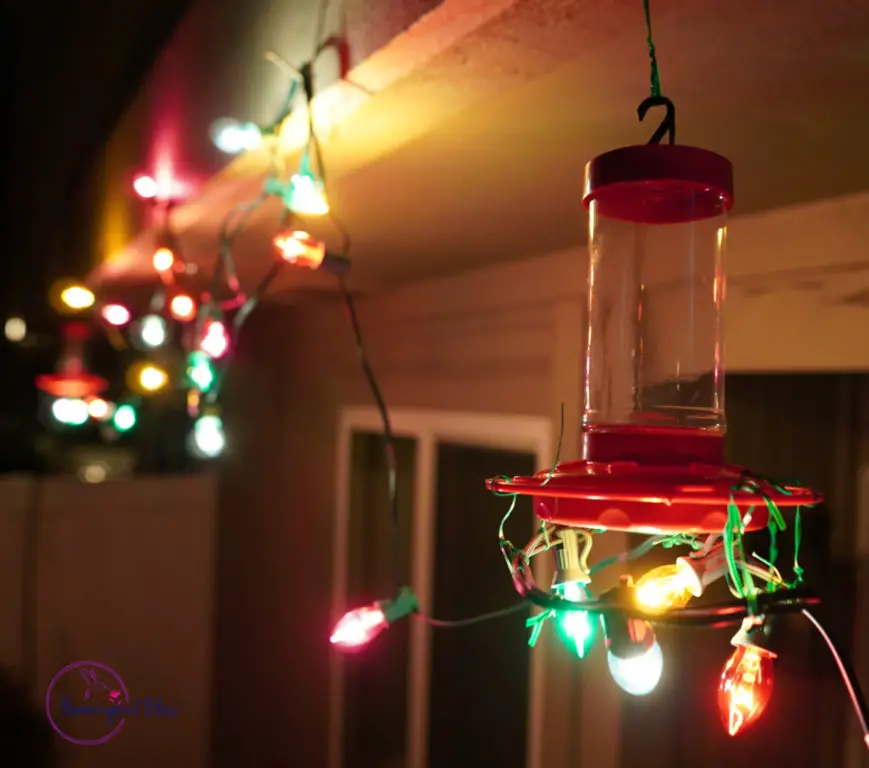
Backyard Visitors is a participant in the Amazon Services LLC Associates Program, an affiliate advertising program designed to provide a means for sites to earn advertising fees by advertising and linking to Amazon.com. We also participate in other affiliate programs which compensate us for referring traffic.

